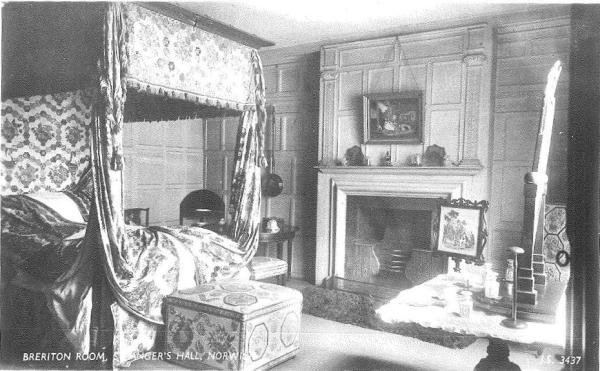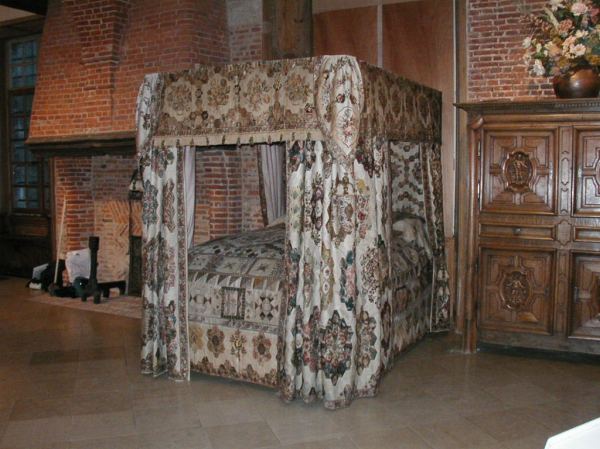Sandwiched between records in the museum’s accession register for 1929 recording gifts of ‘The art of Garden Design in Italy’ and ‘A green-backed gallinule’ from Hickling is a tantalising brief entry recording the donation by Miss Brereton of Briningham Hall of a mahogany bedstead fitted with damask patchwork, and furniture for a room of 1800 – 1810.
The donor was Katherine Blanch Brereton, great-great granddaughter of Anna Margaretta Brereton, the designer and maker of the wonderful Brereton hangings, currently on display in ‘Frayed’.
In this blog post I would like to pay tribute to this remarkable woman. As the result of Katherine’s foresight and generosity Strangers’ Hall gained its single most interesting collection, and certainly the one that has delighted generations of visitors, textiles researchers and family historians over the years.
Born in Norwich in 1861, Katherine overcame parental opposition to take up a career in nursing and made her mark as a nurse in South Africa during the Boer War. Her obituary in The British Journal of Nursing October 1930 reads;
We much regret to record the death of Miss Katherine Blanche Brereton, M.B.E., R.R.C., J.P., and a member of the Guy’s Hospital Nurses’ League. She received training as a lady pupil at Guy’s Hospital from June, 1890 to June 1891, and after working as a Staff Nurse at the Wirral Children’s Hospital, she obtained her midwifery training at the York Road Lying-in Hospital, returning to Guy’s as Sister of Bright Ward in 1893. In 1899 she went out to South Africa on the Staff of the first Imperial Yeomanry Hospital at Deelfontein. In 1901 the Government appointed Miss Brereton a member of the Royal Commission appointed to inquire into the Management of the Concentration Camps in South Africa. She visited all the Camps in the four colonies, and on returning to England in February 1902 received with her Col- leagues the thanks of the House of Commons, and during that year also the South African War Medal and the Royal Red Cross. In I903 she accompanied Mrs. Fawcett (afterwards Dame Millicent) to South Africa on a mission to promote the conciliation of Boers and Britons, and later set herself to learn farming in order to manage the family estates. Her final gift was the bequest of her body to the Medical School of Guy’s Hospital.
On her return to Norfolk in later life, Katherine took on the administration of the family estate, became a JP and was heavily involved in the Temperance Movement, no doubt exciting controversy by closing her local village pub. Clearly she also belonged to that group of influential supporters whose efforts did so much to bolster the Norwich museums in the 1920s and 1930s.
What prompted Katherine to make the donation to Strangers’ Hall we shall never know. The set was given during the year before she died, and apparently despite some opposition from elsewhere in the family, but we might guess that she had a hunch that this family heirloom had a significance above and beyond a set of patchwork hangings, beautiful though they are in their own right. It was a sure instinct…
Around this time a forward-thinking curator of Strangers’ Hall, Frank Leney, was exploring open display interpretation in room settings’ based on Scandinavian models of folk life museum. He was thrilled to accept a donation which allowed him, at one stroke, to display an 18th century Norfolk lady’s bedroom, complete with all its furniture, furnishings and textiles. No other donor contributed in this way. Katherine’s gesture, intended to ‘enhance and enrich the displays’, accorded well with Leney’s ambitions to set up Strangers’ Hall as the museum of English Folk Life . Everything was displayed in ‘The White Room’ (now the Walnut room), where it proved a massive visitor draw. Some thirty years later Pamela Clabburn, the former curator who did so much to enrich and publicise the NMS costume and textiles collections, found the set in a poor state. Together with a small team of enthusiasts, she conserved the set according to the standards of the day and rolled the hangings to minimise further light damage.
In 2003, NMS received a request to include the bed-hangings in the prestigious international exhibition ‘In search of the Hexagon’ at the Château de Martainville, near Rouen, curated by Janine Jannière. Further conservation work allowed the set to be safely displayed on a specially constructed bed-frame, designed by Melanie Leach, textile conservator. And this year, it has formed one of the highlights of ‘Frayed’.
Katherine can’t possibly have anticipated the continuing relevance and excitement of the hangings to successive generations of museum visitors. The interest for me as a curator is the way in which the perceived historical value of key pieces like the Brereton bed-hangings change over time. Such objects can be appreciated in terms of fashion and design, technology and construction or family history, but the comparatively modern reading in the context of the therapeutic role of textiles and the idea of ‘emotional objects’ is undoubtedly the most potent.
I like to think that Katherine would have approved whole-heartedly of their inclusion in Frayed as a ‘textile on the edge’.
With thanks to the Brereton family for kind assistance with research for this blog post.




Wonderful blog, Katherine the donator of the Brereton bed hangings really was a remarkable woman – the world should know.